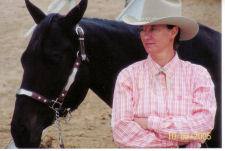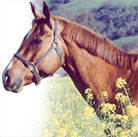| Article Archives
Starting
your own colt
Colt Starting
Quiz
Problem Horses,
part 1
Fear
Problems, part 2
Bad
Actors, part 3
The
Cold Backed Horse
Want
to Compete?
Bit Basics
Going
Places
Common
Sense, Horse Sense
Horsemen's
Christmas
Rainy Day
Training
Try Something
Different!
Green Broke
Resolution
Time
Going in
Circles
Hot Enough
for Ya?
Pleasure
or Equitation?
Return
to Work Carefully
Saving
your "Good Stuff"
Holding
Western Reins
Keep Your
Eyes on the Prize
Cold Weather
Warm Up
Expect
the Unexpected, 1
Expect
the Unexpected, 2
Bad Attitude
Horse of
a Better Color?
Power of
Exercise
Importance
of the Herd
Bath Time
Even Up
Choosing
a Martingale
Showmanship
A Good Night's Sleep
Alternative Therapies, Part One
Alternative Therapies, Part Two
Get the Most out of a Clinic
Blanket or No Blanket?
Does Practice Make Perfect?
A Change of Pace
|
The Power Of Observation
How carefully do you observe your horse? You may be thinking, “Well, I see my horse every day when I feed …” but there is a big difference between noticing whether the horse is standing up when you toss hay over the fence, and taking a good look at him. Being able to recognize your horse’s own individual stance and movement patterns can make detecting a problem as easy at taking a good look at him, even from a distance.
If you have the opportunity to check your horse at different times during the day, you will start to recognize behavior patterns. For example, my herd prefers to graze in certain areas in the morning and other places later in the day. Many of them like to nap at about 10 am, and it is not unusual for the younger mares to graze on a very steep hillside while the old mare (with the bad knees) tends to stay lower down on the more gentle slope. Why does this matter? If I look out and see one of the young mares by herself at the bottom of the hill while the others are at the top, it indicates that something might be wrong, possibly a lameness or injury that prevents the mare from staying in her normal routine and with the other horses. A bad limp is fairly easy to spot from a distance, but even more subtle problems such as the early stages of colic, can be detected if you know your horse’s behavior and body language. A horse standing with his tail tucked and back “roached” can indicate discomfort, and that silhouette is observable from a distance.
Horses are both herd animals, and individuals. There is the normal behavior of the herd – the tendency for the group to shade up, nap, or go to the water trough at certain times – and then the normal patterns for each as individuals. Some horses are voracious eaters. Nothing comes between them and their food, and they eat up every last stem of hay. Others are more casual, might leave their feed and then come back later to finish (if someone else hasn’t done that for them!). Knowing which is a normal pattern for your horse can again help detect the beginnings of problems, even if you are just driving by. I certainly know if I see Annie Crest NOT eating something is very wrong, while JD routinely takes a nap in the middle of breakfast.
A careful observer will detect each horse’s body language to the extent of knowing which leg the horse usually rests. A horse that always rests one hind leg and never the other may have a back or joint problem. Some horses will always graze with the same foreleg ahead of the other. These patterns can indicate a body issue than may need to be addressed by a veterinarian, chiropractor or other body worker, or they might just be the habit of that individual horse. Noticing changes in the pattern can alert you to changes happening to your horse in time to do something, if necessary.
Sometimes changes can be a positive indication, too. A gelding that was getting treatment for lower back problems started to shift his weight from the left hind leg to the right, and back. Considering that before the back problems were treated, he consistently stood with the right hind resting (all of his weight always borne on the left hind leg), this shifting indicated that the treatment was helping him. One day I noticed the gelding standing with his left hind leg cocked and all his weight on the previously weak right hind. A breakthrough! By knowing his “normal” body patterns, I could gage his improvements, and begin observing his new, positive patterns.
 Doris
Eraldi of Eraldi Training in Potter Valley, specializes
in training for all around horsemanship. She can be
contacted at 707-743-1337, or by e-mail dyan@eraldi.net, or read her blog at Horseman's Diary Doris
Eraldi of Eraldi Training in Potter Valley, specializes
in training for all around horsemanship. She can be
contacted at 707-743-1337, or by e-mail dyan@eraldi.net, or read her blog at Horseman's Diary
<< Back
to Rainbow Ag Horse Home Page |
